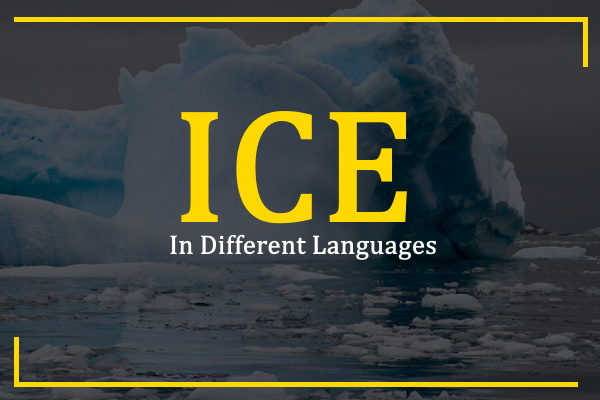Table of Contents
Ice in Different Languages: Ice is the frozen solid state of water. It may seem transparent or somewhere in between opaque, blue white, in accordance with the presence of impurities like soil particles or air bubbles. It is plentiful on the surface of the earth, especially in polar regions and above the snowline, and plays a major role in the earth’s water cycle and climate as a common form of evaporation and deposition. It falls in the form of snowflakes and hail or spikes of ice.
Ice in All Languages
Translation of word Ice in almost 100+ different languages of the world.
| Different Languages | Word Ice |
|---|---|
| Albanian | akull |
| Basque | izotz |
| Belarusian | лёд |
| Bosnian | led |
| Bulgarian | лед |
| Catalan | gel |
| Croatian | led |
| Czech | led |
| Danish | is |
| Dutch | ijs- |
| Estonian | jää |
| Finnish | jää |
| French | glace (ɡlas) |
| Galician | xeo |
| German | Eis |
| Greek | πάγος (págos) |
| Hungarian | jég |
| Icelandic | Ís |
| Irish | oighear |
| Italian | ghiaccio |
| Latvian | ledus |
| Lithuanian | ledas |
| Macedonian | мраз |
| Maltese | silġ |
| Norwegian | is |
| Polish | lód |
| Portuguese | gelo |
| Romanian | gheaţă |
| Russian | лед (led) |
| Serbian | лед (led) |
| Slovak | ľad |
| Slovenian | led |
| Spanish | hielo |
| Swedish | is |
| Ukrainian | лід (lid) |
| Welsh | iâ |
| Yiddish | ייַז |
| Armenian | սառույց |
| Azerbaijani | buz |
| Bengali | বরফ |
| Chinese Simplified | 冰 (bīng) |
| Chinese Traditional | 冰 (bīng) |
| Georgian | ice |
| Gujarati | બરફ |
| Hindi | बर्फ |
| Hmong | ice |
| Japanese | 氷 |
| Kannada | ಐಸ್ |
| Kazakh | мұз |
| Khmer | ទឹកកក |
| Korean | 얼음 (eol-eum) |
| Lao | ກ້ອນ |
| Malayalam | ഐസ് |
| Marathi | बर्फ |
| Mongolian | мөс |
| Myanmar (Burmese) | ရေခဲ |
| Nepali | बरफ |
| Sinhala | අයිස් |
| Tajik | ях |
| Tamil | பனி |
| Telugu | మంచు |
| Thai | น้ำแข็ง |
| Turkish | buz |
| Urdu | برف |
| Uzbek | muz |
| Vietnamese | Nước đá |
| Arabic | جليد (jalid) |
| Hebrew | קֶרַח |
| Persian | یخ |
| Afrikaans | ys |
| Chichewa | ayezi |
| Hausa | kankara |
| Igbo | ice |
| Sesotho | leqhoa |
| Somali | baraf |
| Swahili | barafu |
| Yoruba | yinyin |
| Zulu | ice |
| Cebuano | yelo |
| Filipino | yelo |
| Indonesian | Es |
| Javanese | es |
| Malagasy | ranomandry |
| Malay | ais |
| Maori | tio |
| Esperanto | glacio |
| Haitian Creole | glas |
| Latin | glacies |
Ice in European Languages
Translation of word Ice in almost 42 European languages.
| Different Languages | Word Ice |
|---|---|
| Albanian | akull |
| Basque | izotz |
| Belarusian | лёд |
| Bosnian | led |
| Bulgarian | лед |
| Catalan | gel |
| Corsican | ghjacciu |
| Croatian | led |
| Czech | led |
| Danish | is |
| Dutch | ijs- |
| Estonian | jää |
| Finnish | jää |
| French | glace [ɡlas] |
| Frisian | iis |
| Galician | xeo |
| German | Eis |
| Greek | πάγος [págos] |
| Hungarian | jég |
| Icelandic | Ís |
| Irish | oighear |
| Italian | ghiaccio |
| Latvian | ledus |
| Lithuanian | ledas |
| Luxembourgish | Äis |
| Macedonian | мраз |
| Maltese | silġ |
| Norwegian | is |
| Polish | lód |
| Portuguese | gelo |
| Romanian | gheaţă |
| Russian | лед [led] |
| Scots Gaelic | deigh |
| Serbian | лед [led] |
| Slovak | ľad |
| Slovenian | led |
| Spanish | hielo |
| Swedish | is |
| Tatar | боз |
| Ukrainian | лід [lid] |
| Welsh | iâ |
| Yiddish | ייַז |
Ice in Asian Languages
Translation of word Ice in almost 36 Asian languages.
| Different Languages | Word Ice |
|---|---|
| Armenian | սառույց |
| Azerbaijani | buz |
| Bengali | বরফ |
| Chinese Simplified | 冰 [bīng] |
| Chinese Traditional | 冰 [bīng] |
| Georgian | ice |
| Gujarati | બરફ |
| Hindi | बर्फ |
| Hmong | ice |
| Japanese | 氷 |
| Kannada | ಐಸ್ |
| Kazakh | мұз |
| Khmer | ទឹកកក |
| Korean | 얼음 [eol-eum] |
| Kyrgyz | муз |
| Lao | ກ້ອນ |
| Malayalam | ഐസ് |
| Marathi | बर्फ |
| Mongolian | мөс |
| Myanmar (Burmese) | ရေခဲ |
| Nepali | बरफ |
| Odia | ବରଫ |
| Pashto | يخ |
| Punjabi | ਬਰਫ |
| Sindhi | برف |
| Sinhala | අයිස් |
| Tajik | ях |
| Tamil | பனி |
| Telugu | మంచు |
| Thai | น้ำแข็ง |
| Turkish | buz |
| Turkmen | buz |
| Urdu | برف |
| Uyghur | مۇز |
| Uzbek | muz |
| Vietnamese | Nước đá |
Ice in Middle East Languages
Translation of word Ice in 4 middle eastern languages.
| Different Languages | Word Ice |
|---|---|
| Arabic | جليد [jalid] |
| Hebrew | קֶרַח |
| Kurdish (Kurmanji) | qeşa |
| Persian | یخ |
Ice in African Languages
Translation of word Ice in almost 13 African languages.
| Different Languages | Word Ice |
|---|---|
| Afrikaans | ys |
| Amharic | በረዶ |
| Chichewa | ayezi |
| Hausa | kankara |
| Igbo | ice |
| Kinyarwanda | urubura |
| Sesotho | leqhoa |
| Shona | chando |
| Somali | baraf |
| Swahili | barafu |
| Xhosa | umkhenkce |
| Yoruba | yinyin |
| Zulu | ice |
Ice in Austronesian Languages
Translation of word Ice in almost 10 Austronesian languages.
| Different Languages | Word Ice |
|---|---|
| Cebuano | yelo |
| Filipino | yelo |
| Hawaiian | hau |
| Indonesian | Es |
| Javanese | es |
| Malagasy | ranomandry |
| Malay | ais |
| Maori | tio |
| Samoan | aisa |
| Sundanese | es |
Ice in Other Foreign Languages
| Different Languages | Word Ice |
|---|---|
| Esperanto | glacio |
| Haitian Creole | glas |
| Latin | glacies |
Video Translation of Ice in 10 Other Languages
Coming Soon…
More Information about Ice
Ice extends from the biggest form of called ice sheet to smaller ice caps and lakes of ice, including glaciers, ice streams and snowfields.
Ice formation on flowing water appears to be less stable and consistent than ice forming on calm water. If fragmented blocks of ice are piled up, ice jams are the main ice hazard in the rivers. Ice jams can lead to floods, damage in or around the river and damage to the river vessels.
For decades, human beings have been using ice for cooling and food protection, focusing on natural ice harvesting in different forms and then moving to mechanical material production.
Dry ice is carbon dioxide’s solid form. It is mainly used as a refrigerant. It has a lower temperature than ice water and thus no residue is left.
It is helpful when mechanical cooling is not available for the preservation of frozen food. Slurry ice is a changing phase refrigerant shaped and stored in a water solution and a tranquilliser with a freezing point, consisting of millions of ice “micro-crystal”
Water ice may refer to water-formed ice such as Italian ice, fruit desserts, and ice made from flowing water.

Arslan Hussain, founder of The Different Languages, is an experienced translator passionate about languages and cultures. Through his website, he shares his knowledge and love for different languages, making learning accessible and enjoyable.

